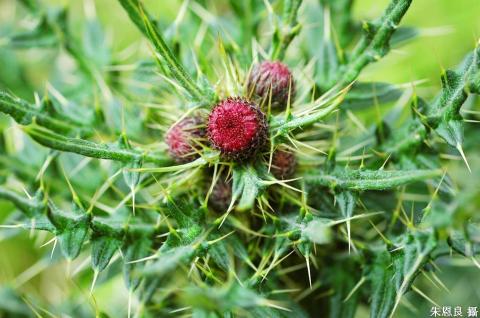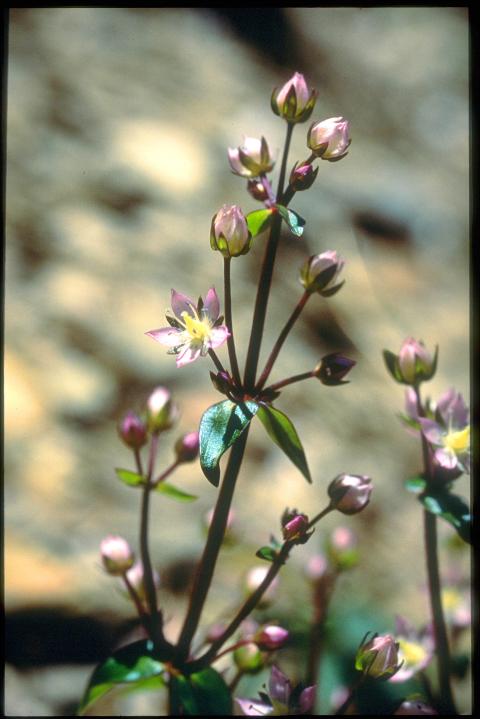At an international conference on Sept. 26, Academia Sinica academician Chou Chang-hung said that with the onset of global warming, wild plant species at average to high altitudes have been showing a tendency to migrate to higher altitudes, adding that if these species continue to migrate they will eventually reach a point where there is nowhere to grow. Chou says that six plant species indigenous to Taiwan, including Yushan’s Hypericum nagasawai, will soon face extinction, and says that the preservation of genetic resources brooks no delay.
The Taiwan Endemic Species Research Institute (TESRI) under the Council of Agriculture held the International Conference on the Collection and Preservation of Plant Genetic Resources on Sept. 26, with Peter H. Raven, a former science consultant for the Clinton administration and longtime director of the Missouri Botanical Garden, around a dozen other international experts from South Africa, England, Germany and China, as well as Academia Sinica’s Chou, Lee Chia-wei, a professor in National Ching Hua University’s Department of Life Sciences, and Chiu Chi-jung and Chung Kuo-fang, both professors in National Taiwan University’s School of Forestry and Resource Conservation, presenting papers at the conference.
Chou says research shows that from 1906 to 2006 plant life at average to high altitudes in the Hehuanshan area gradually migrated to higher altitudes due to global warming, averaging 3.6m per year. If this migration trend is not slowed down, there will eventually be no more land available for the plants to grow, meaning that at least six of Taiwan’s native plant species — Anaphalis morrisonicola, Artemisia morrisonensis, Swertia randaiensis, Hypericum nagasawai, Angelica morrisonicola, and Cirsium arisanensis — potentially face extinction.

Photo courtesy of the Endemic Species Research Institute
照片由特有生物研究保育中心提供
TESRI director Tang Hsiao-yu says that they are currently in the process of planning facilities for the preservation of plant species in high-altitude mountain areas. Still at the preliminary phase of planning, they have decided to create a preservation area at Hehuanshan and will be working to collect and preserve 500 or so of the plant genetic resources currently growing at high altitudes there. With enough manpower and funding, the institute hopes to expand its collection and preservation endeavors to Southeast Asia in the future, potentially benefiting their work by holding exchanges with international experts and learning from the experiences of others, Tang says.
(Liberty Times, Translated by Kyle Jeffcoat)
全球氣候暖化,中高海拔野生植物出現往高海拔地區遷移生長的趨勢,中研院院士周昌弘九月二十六日在一場國際研討會中提出警訊,強調若高山植物持續往高處遷移,未來將無處可去,而台灣特有種的玉山金絲桃等六種植物恐將絕滅,種原蒐藏保育已刻不容緩。

Photo courtesy of the Endemic Species Research Institute
照片由特有生物研究保育中心提供
農委會特有生物研究保育中心二十六日舉辦植物種原蒐集與保育國際研討會,包括曾任美國前總統柯林頓科學顧問的密蘇里植物園園長彼得‧雷文與來自南非、英國、德國與中國等十二名國際專家學者與中研院院士周昌弘、清大生命科學系教授李家維與台大森林資源系教授邱圻榮、鍾國芳均與會發表報告。
周昌弘指出,從一九○六至二○○六年之間在氣候暖化影響下,研究紀錄顯示在合歡山區的中高海拔野生植物,每年以三點六公尺速率往高海拔遷移生長,若此趨勢未見減緩,最後將無處可去,其中至少有玉山抱莖籟簫、細葉山艾、巒大當藥、玉山金絲桃、玉山當歸與阿里山薊等六種植物極可能面臨絕滅。
特生中心主任湯曉虞表示,目前正積極籌設高山植物種原保存設施,初步選定合歡山地區設立保存場地,就現有五百多種高山植物種原進行蒐藏保存,未來若人力、財力允許更將擴展蒐藏範圍至東南亞地區,藉著國外學者專家的經驗交流,有助推動種原保存工作。
(自由時報記者陳信仁)

A: Hey, the world’s major dictionaries just unveiled their words of the year for 2025. B: Yup, the Cambridge Dictionary chose the word “parasocial,” which refers to a connection that someone feels between themselves and a famous person they don’t really know. A: One-sided parasocial relationships with celebrities, influencers and even AI chatbots have clearly become more common. B: The Oxford Dictionary picked “rage bait” — online content designed to elicit anger by being frustrating, provocative or offensive in order to increase traffic to Web sites or social media accounts. A: The Collins Dictionary picked “vibe coding.” Let’s

A: Apart from the world’s major dictionaries, the online Dictionary.com actually picked “67” as its word of the year. B: What does “67” even mean? A: Even the dictionary wasn’t exactly sure about its meaning. The slang term’s origin might be traced to US rapper Skrilla’s song Doot Doot (67). Aren’t Taiwanese media outlets choosing the Mandarin word for 2025? B: Yeah and after hearing the song Good-for-Nothing, adapted from some catchphrases of Legislator Wang Shih-chien, I’m going to vote for the character “tsung” (hasty) from the lyrics. A: Hopefully, in the new year, we’ll be calm as the

Sea star wasting disease (SSWD) is a strange and serious illness affecting sea stars, or starfish. This disease causes sea stars to develop painful lesions, lose their arms, and eventually turn into a gooey, melted mess. Since it was first observed in 2013, millions of sea stars along the Pacific coast of North America have died from this __1__. Although viruses were once considered a possible cause, researchers now believe that environmental stressors and microorganisms are primarily __2__ for sea star wasting disease. One of the main environmental triggers appears to be warmer ocean water. When the water heats

Continued from yesterday(延續自昨日) https://www.taipeitimes.com/News/lang The loss of sea stars significantly impacts the ocean ecosystem. Sea stars are important __6__ that help control populations of mussels and sea urchins. Among them, the sunflower star is one of the largest and fastest sea stars and is adept at preying on sea urchins. Without sea stars, sea urchins can __7__ in numbers and devastate kelp forests. These forests are essential __8__ for many marine animals and also help capture carbon from the atmosphere, which is vital in the fight against climate change. The mystery behind SSWD is still __9__, but it is clear that